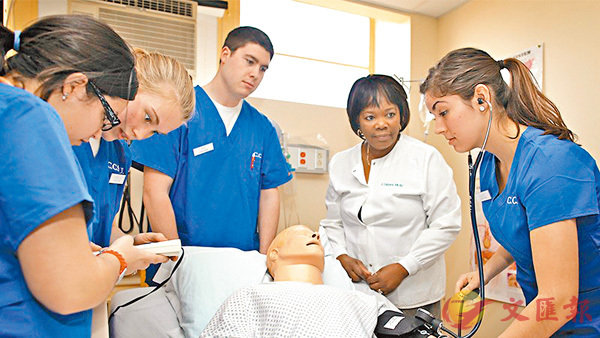 ■美國不少醫院為解決護士荒,推出如學費補貼、免費住宿等條件吸引新血和留住舊員工。圖為美國護士學校上課情況。 網上圖片
■美國不少醫院為解決護士荒,推出如學費補貼、免費住宿等條件吸引新血和留住舊員工。圖為美國護士學校上課情況。 網上圖片【原文】下文摘錄自香港《文匯報》2017年10月21日報道:
最近,美國(United States)爆出幾十年來最嚴重「護士荒」,全國各地的大中小型醫院均面臨人手(manpower)不足,即使大幅調升人工和簽約獎金(signing bonus),甚至推出代還學債(student loan)、免費住宿(accommodation)等豐厚福利,依然是一人難求,只能靠輸入外勞(imported labor)或臨時工(temporary worker)填補空缺。不少較小型醫院更因為相關的龐大開支,陷入經營危機。
高薪聘臨時工 護病人利益
西弗吉尼亞州(West Virginia)最大型醫院「查爾斯頓地區醫療中心」(Charleston Area Medical Center),今年動用了1,200萬美元(約9,360萬港元)招聘稱為「走訪護士」(travel nurse)的臨時護士,以解燃眉之急,金額比3年前增加一倍,醫院赤字(deficit)亦因此暴增至4,000萬美元(約3.12億港元)。
為了吸納新血,院方亦向護士生埋手,只要承諾畢業後在醫院工作兩年,便可得到學費補貼(tuition reimbursement)。
本月剛退休的醫院首席護士長(chief nursing officer)穆爾(Ron Moore)指,他從業40年來,從沒有見過這麼嚴重的「護士荒」,但認為「請一名走訪護士,總好過少一張病床」。
不少醫院都和查爾斯頓地區醫療中心一樣,寧願花錢高薪請人,也不想犧牲(sacrifice)病人利益。人力資源顧問(human resource advisor)估計,美國醫療界走訪護士開支今年將達到48億美元(約374.4億港元),是3年前的兩倍。
預計2024缺100萬人手
美國以往也發生過「護士荒」,但今次更嚴重,勞工數據局(Bureau of Labour Statistics)估計到2024年,全美將有超過100萬護士空缺。
護士荒的主因是嬰兒潮一代(baby boomer generation)年事漸高,令護理需求大增,同時卻有大批資深護士退休(retirement);此外,護士學位嚴重不足,也導致業界青黃不接。
傳統大型醫院工作較辛苦,亦令不少護士轉投工時較彈性的(flexible)小型診所(clinic)或保險公司診所。
護士荒對病人利益構成直接影響,今年8月一項研究指,醫院如果註冊護士(registered nurse)人手不足,病人在一般手術(surgery)後死亡的風險(risk of death)較高。
"Money for talents" to face nursing shortage in the US
【譯文】The United States is experiencing the most serious nursing shortage over the recent decades, of which both large and small hospitals nationwide are severely short of manpower. Although the hospitals are actively taking measures such as increasing salaries and signing bonuses significantly, or even providing generous welfare benefits like paying off student loans for employees and offering free accommodation, it is still hard to recruit nursing talents, and some even fill up the job vacancies by simply hiring foreign or temporary nurses. Certain small hospitals, however, are falling into financial crisis because of huge expenditures.
High expenses spent on "travel nurses"
The Charleston Area Medical Center, the largest hospital in West Virginia, is spending US$12 million (approximately HK$93.6 million) this year-the amount of money doubled that of three years ago-to recruit the "travel nurses" to deal with the current situation. As a result, its deficit has rocketed to US$40 million (approximately HK$312 million).
In order to attract new staff, the center also offers great incentive to nursing students that they will be given tuition reimbursement if they commit to work in the center for no less than two years after graduation.
Ron Moore, the chief nursing officer of the center who has just retired this month, said that he had never experienced such severe shortfall of nursing staff in almost 40 years, but thought "it's better to pay a traveler than to shut a bed".
A number of hospitals are similar to the Charleston Area Medical Center, preferring to recruit nursing talent with higher salaries rather than sacrificing the patients' interests. A human resource advisor estimated that the total cost nationwide for hiring travel nurses this year would reach US$4.8 billion (approximately HK$37.44 billion), which would be twice as many expenses than three years ago.
One million vacancies expected in 2024
The U.S. has also had nursing shortfall in the past, but the lack of staffing is worse. The Bureau of Labour Statistics estimated that there would be over one million vacancies of nursing positions by 2024. A major cause of the problem is the ageing of the baby boomer generation, pushing up the demand for nursing care, added with a new wave of retirements of the trained nurses.
Furthermore, the enrolment quotas in the nursing schools are far from enough to nurture sufficient nursing professionals to meet market demand. The hospitals are facing even more competition with private clinics and insurance companies that may offer more flexible working hours, compared with the relatively harsh conditions in traditional hospitals.
The nursing shortage has a direct impact on the patients' interests. A study released in August this year indicated that insufficient registered nurses in the hospitals may cause the patients to face higher risk of death after surgery.■龐嘉儀
Q&A
1. 除了美國,哪些國家或地區同樣面臨護士荒?
2. 一般而言,護士與病人比例的國際水平為多少?
3. 香港目前的護士比例約為多少?
4. 高齡化增加護理需求。聯合國世界衛生組織(World Health Organization)如何定義「高齡社會」?
5. 哪個亞洲國家已進入超高齡社會?
1. 香港、台灣、日本、英國等
2. 1:4-6(1名護士對4名至6名住院病人)
3. 1:10
4. 65歲以上人口達7%為高齡化社會(ageing society);達14%為高齡社會(aged society);達20%則為超高齡社會(super-aged society)
5. 日本(老齡人口佔25%以上)

